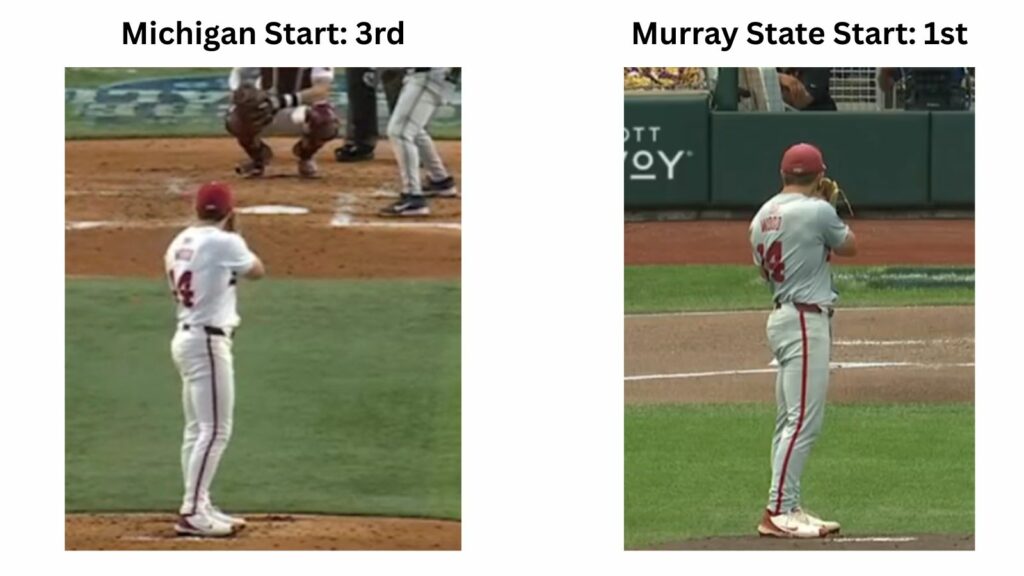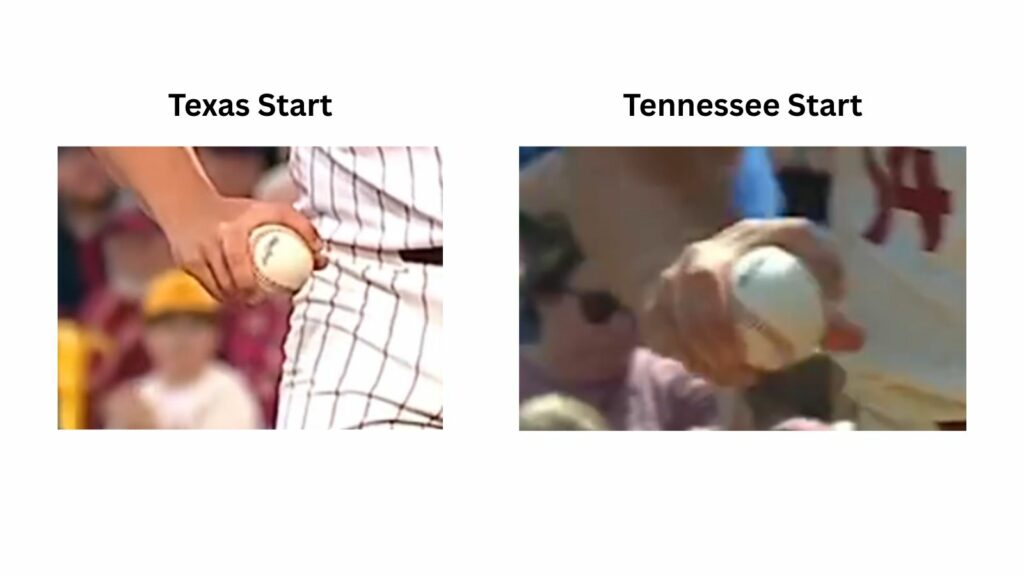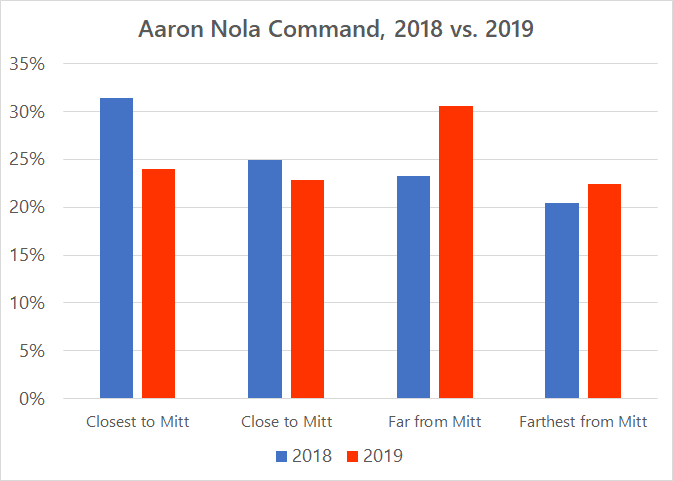Photo: Andy Altenburger/Icon Sportswire
MLB Draft Scouting Report: Gage Wood
| Skill | Grade |
| RHP | |
| Fastball | 70 |
| Cutter/Slider | 55 |
| Curveball | 60 |
| Splitter | 50 |
| Control/Command | 50/50 |
| Future Value | 55+ |
Name: Gage Wood
College: University of Arkansas
Bio: R/R 6-0, 205 lbs.
DOB: 12/15/2003
Written by Brandon Tew
Analysis:
Gage Wood arguably has the loudest stuff in the entire college draft class. His arsenal is a noisy and brash heavy metal band. He stares with laser focus towards the batter, giving off angry vibes. “Here’s my fiery fastball and buzzsaw curveball, try to hit it…”
Add in a cutter/slider that is hard with good shape, and you have the makings of three distinct offerings and an aggressive pitcher that knows he has overpowering stuff.
If Wood succeeds in MLB he will continue to wield an ultra-productive fastball to pair with a big breaking pitch that he can throw in the mid-80s with a downer shape. He’ll do this all while throwing strikes and keeping the ball out of the heart of the plate as he refines his command.
If Wood hits a snag, it will be possible for him to sustain further injuries. Shoulder injuries can be complex.
Or he’ll lack true command of his fastball and curve, with no viable, consistent armside pitch to keep hitters honest and never gets a feel or command for the splitter that he rarely threw in 2025, but has been tinkering with.
College Career:
In Wood’s first two seasons in Fayetteville, he was a power reliever. After making the transition to the rotation, he had some bad luck, as he was removed from an outing in February against Michigan with a shoulder impingement.
The Razorbacks shut down Wood until mid-April limiting him to just 10 uneven starts and pitch counts and just 37 ⅔ innings. Wood’s powerful arsenal was on display late in the season when he twirled a 19-strikeout no-hitter vs Murray State in an elimination game at the College World Series.
I’m not sure if it was ever a discussion to take the ball out of Wood’s hands, but I would venture to guess he would have told anyone who asked that it was his game and his ball.
| Year | ERA | IP | K% | BB% |
| 2023 | 4.80 | 30 | 30% | 16% |
| 2024 | 4.46 | 40 1/3 | 32% | 5% |
| 2025 | 3.82 | 37 2/3 | 46% | 5% |
Pitching Mechanics:
Out of the windup, Wood starts with his lower half fully turned to face third base. He rotates his upper body to have his glove in front of his face as he peers over the top.
He steps with his left foot to first base and rocks back, dropping his glove to his stomach. He smoothly brings his leg up to his glove during the leg lift, and as he does so, he counter-rotates his hips, creating momentum forward.
As he drives his front hip to the plate, he straightens out his lead leg with his toe pointed up to the sky at about a 45-degree angle made with his leg and left foot.
He holds himself in a close position down the mound as he enters a front-foot strike. He’s smooth getting down the mound, but has a fast arm action as he goes to land.
With his right arm flipped up around a 45-degree angle, you can see the scap retraction in his throwing shoulder as he enters a power position with his chest and weight leaning into his front foot.
Finishing with his chest out over his knee, he transfers energy through a lead leg block that drives force up to his throwing arm. He usually recoils his arm quickly in a brief motion. He brings it back to his body quickly after ball release, as his leg swings through in a straightened position.
One quirk in Wood’s delivery is that he pats the ball throughout his move into hand brake, almost using it as a method of rhythm to keep him on tempo throughout the delivery.
Wood moved over to the extreme first base side for the Murray State no-hitter, which is likely due to the angles.
Gage Wood positioning on pitching rubber:

Arsenal:
4s: 95-97 mph avg, 17” IVB, 10” Arm-side | Release: 5.5’
Wood throws his four-seam with giddyup behind it, and the ball has good carry through the top of the zone. From a lower release height, the ball zooms past hitters, and he squeezes the pitch hard.
He has a slight supination bias, meaning he throws the ball with a slight cut at times. Still, on the four-seam, he tries to stay behind the ball and rip down on the seams to create backspin, which he does pretty well based on how his fingers align on the ball in his grip and how they interact at release.
Against either handedness, his catcher sets up the middle of the plate, up or down—his locations on the fastball against right-handed hitters are slightly more to the top shelf. While against left-handed hitters, Wood’s fastball command was more middle shelf in the zone.
He was highly aggressive in the zone with his fastball, running an above-average heart-of-the-plate percentage this season, although it was a smaller sample. Arkansas wanted Wood in the zone and with good reason, as he ran a 32% zone-whiff rate on the pitch against righties and a 46% zone-whiff rate versus lefties.
The pitch, with a flat vertical approach angle of around -4.1, completely obliterates hitters as they swing underneath it. If Wood can continue to refine his command to more average or maybe even above-average at best, he can start to punish hitters at the top rail, leaning into the excellent traits of the pitch that already exist.
He gets the ball up, but it will start to be scary for hitters if he can throw fastballs away and then work the pitch up with two strikes. That’s when he can start changing eye levels with that pitch.
Here are some fastball stats from Wood’s 19-strikeout no-hitter:
Gage Wood’s fastball was electric:
• Threw 58 of 71 fastballs for strikes (82%)
• 25 whiffs on 45 swings vs his fastball (56%)
• 18 of his 27 outs came via his fastball
• 13 of his 19 K came via his fastball
— Mike Monaco (@MikeMonaco_) June 16, 2025
Curveball: 82-85 mph avg, -16” IVB, 11” Sweep
The curve is a banger pitch, and his teammates have aptly named it the banger as well. The pitch is at times a hard vertical snap dragon at 83-85 mph. He can also get more to the side of the ball and create some more sweep on the pitch if needed.
This manipulation is intriguing and could help him continue to throw it to both right-handed and left-handed hitters. Either way, the pitch with so much depth at that velocity is hard to come by even in MLB. If the pitch tightens up a bit, it should still perform inside of his arsenal.
It becomes a guessing game when Wood is blazing heaters by a hitter and then rips off a massive breaker out of the high fastball tunnel. In terms of usage, Wood is a two-pitch pitcher with a double-plus fastball and a plus curveball. Maybe he pushes the velocity more to 85-87 mph, and the break is shorter; it could be a double-plus breaker if he starts to have more command.
With a big spike on his grip, Wood gets to the front of the baseball with intent better than most, creating hard topspin, producing a gnarly curveball because of it.
Cutter: 87-91 mph avg, 2” IVB, 4” Sweep
Wood’s Cutter lives in the slider range, and he doesn’t love the pitch, but it has some decent shape to it, and he throws it pretty hard. The problem is that Wood has a tiny sample size of just about 50 cutters thrown this season.
With 95% of those thrown to right-handed hitters, it became a wrinkle pitch for Wood against right-handed hitters. There’s hope that Wood can probably add some distinct glove-side breakers to his arsenal, given his little bit of supination bias, which should help him get to the side of the ball better to create spin.
Any version of a gyro slider and cutter at a hard velocity to pair with a possible sweeper could be enticing to the Phillies—a team that promotes a deeper arsenal and cutter usage, in the Majors, and in some of their pitching prospects as well.
Splitter: 86-90 mph Specs: 8” IVB, 11” Arm-side
With only 14 splitters, all thrown to opposite-handed hitters, the pitch just was not thrown much to assess. He does throw the pitch hard and also kills spin on it. Overall, Wood should be able to possess some type of average to fringe-average offspeed pitch.
Here are the grips on the splitter:
 Adding in a seam-shifted two-seam to push righties off the plate would be nice as well. Perhaps even a traditional sinker, even if of poor quality, could help moderate the four-seam usage a bit.
Adding in a seam-shifted two-seam to push righties off the plate would be nice as well. Perhaps even a traditional sinker, even if of poor quality, could help moderate the four-seam usage a bit.
The addition of either a somewhat reliable offspeed pitch or multiple glove-side harder breakers like a cutter and/or sweeper will provide value for Wood.
Projection:
Wood is a high-ceiling right-handed pitcher with a fastball and curveball pairing that tunnels beautifully. Developing some type of armside pitch will benefit his growth more than anything, and it will be intriguing to see what the Phillies focus on in his development early in pro ball.
Wood has some questions about the extent of his workload in college. He’s also a smaller pitcher in terms of stature, and while you do have to factor in durability and injury risk.
From a pure pitch shape and stuff standpoint, Wood has the possible best two-pitch combo in the draft and the foundational building blocks of a mid-rotation starter with some massive upside.
There’s risk and variance in the profile and some reliever risk if the command backs up, but he’s as talented as any pitcher in this draft and a competitive menace on the mound.
Aesthetics Comp: Hunter Brown (Similar Arsenal Characteristics)

